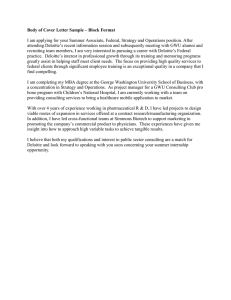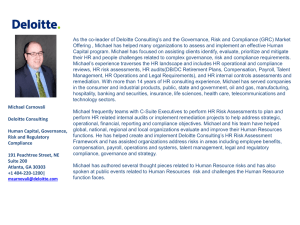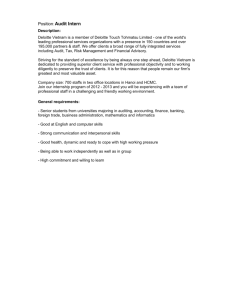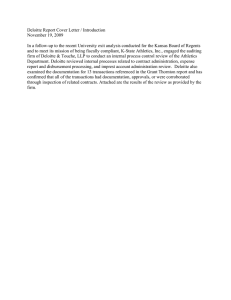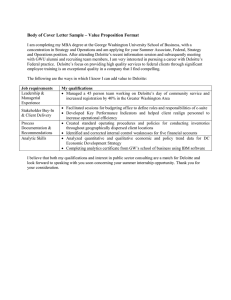Loss Reserving Using Policy-Level Data James Guszcza, FCAS, MAAA Jan Lommele, FCAS, MAAA
advertisement
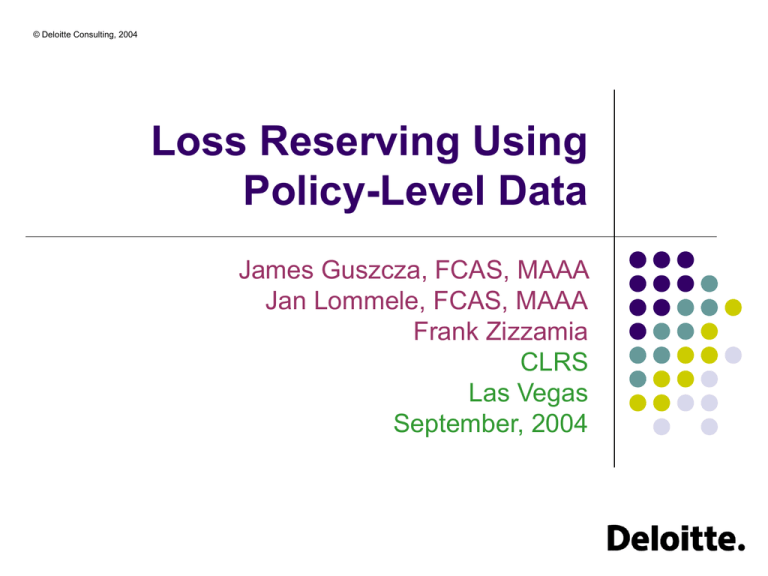
© Deloitte Consulting, 2004
Loss Reserving Using
Policy-Level Data
James Guszcza, FCAS, MAAA
Jan Lommele, FCAS, MAAA
Frank Zizzamia
CLRS
Las Vegas
September, 2004
© Deloitte Consulting, 2004
Agenda
Motivations for Reserving at the
Policy Level
Outline one possible modeling
framework
Sample Results
2
© Deloitte Consulting, 2004
Motivation
Why do Reserving at the Policy
Level?
© Deloitte Consulting, 2004
2 Basic Motivations
1.
Better reserve estimates for a changing
book of business
2.
Do triangles “summarize away” important patterns?
Could adding predictive variables help?
More accurate estimate of reserve variability
Summarized data require more sophisticated models
to “recover” heterogeneity.
Is a loss triangle a “sufficient statistic” for ultimate
losses & variability?
4
© Deloitte Consulting, 2004
(1) Better Reserve Estimates
Key idea: use predictive variables to
supplement loss development patterns
Most reserving approaches analyze summarized
loss/claim triangles.
Does not allow the use of covariates to predict
ultimate losses (other than time-indicators).
Actuaries use predictive variables to
construct rating plans & underwriting models.
Why not loss reserving too?
5
© Deloitte Consulting, 2004
Why Use Predictive Variables?
Suppose a company’s book of business has
been deteriorating for the past few years.
This decline might not be reflected in a
summarized loss development triangle.
However: The resulting change in
distributions of certain predictive variables
might allow us to refine our ultimate loss
estimates.
6
© Deloitte Consulting, 2004
Examples of Predictive Variables
Claim detail info
Type of claim
Time between claim and reporting
Policy’s historical loss experience
Information about agent who wrote the policy
Exposure
Premium, # vehicles, # buildings/employees…
Other specifics
Policy age, Business/policyholder age, credit…..
7
© Deloitte Consulting, 2004
More Data Points
Typical reserving projects use claim data
summarized to the year/quarter level.
Probably an artifact of the era of pencil-andpaper statistics.
In certain cases important patterns might be
“summarized away”.
In the computer age, why restrict ourselves?
More data points less chance of overfitting the model.
8
© Deloitte Consulting, 2004
Danger of over-fitting
One well known example
Overdispersed Poisson GLM fit to loss triangle.
Stochastic analog of the chain-ladder
55 data points
20 parameters estimated
parameters have high standard error.
How do we know the model will generalize
well on future development?
Policy-level data: 1000’s of data points
9
© Deloitte Consulting, 2004
Out-of-Sample Testing
Policy-level dataset has 1,000’s of data
points
Rather than 55 data points.
Provides more flexibility for various out-ofsample testing strategies.
Use of holdout samples
Cross-validation
Uses:
Model selection
Model evaluation
10
© Deloitte Consulting, 2004
(2) Reserve Variability
Variability Components
Process risk
Parameter risk
Model specification risk
Predictive error = process + parameter risk
Both quantifiable
What we will focus on
Reserve variability should also consider
model risk.
Harder to quantify
11
© Deloitte Consulting, 2004
Reserve Variability
Can policy-level data give us a more accurate
view of reserve variability?
Process risk: we are not summarizing away
variability in the data.
Parameter risk: more data points should lead to less
estimation error.
Prediction variance: brute force “bootstrapping”
easily combines Process & Parameter variance.
Leaves us more time to focus on model risk.
12
© Deloitte Consulting, 2004
Disadvantages
Expensive to gather, prepare claim-detail
information.
Still more expensive to combine this with
policy-level covariates.
More open-ended universe of modeling
options (both good and bad).
Requires more analyst time, computer power,
and specialist software.
Less interactive than working in Excel.
13
© Deloitte Consulting, 2004
Modeling Approach
Sample Model Design
© Deloitte Consulting, 2004
Philosophy
Provide an example of how reserving might
be done at the policy level
To keep things simple: consider a
generalization of the chain-ladder
Just one possible model
Analysis is suggestive rather than definitive
No consideration of superimposed inflation
No consideration of calendar year effects
Model risk not estimated
etc…
15
© Deloitte Consulting, 2004
Notation
Lj = {L12, L24, …, L120}
Losses developed at 12, 24,… months
Developed from policy inception date
PYi = {PY1, PY2, …, PY10 }
Policy Years 1, 2, …, 10
{Xk} = covariates used to predict losses
Assumption: covariates are measured at or before
policy inception
16
© Deloitte Consulting, 2004
Model Design
Build 9 successive GLM models
Regress L24 on L12; L36 on L24 … etc
Each GLM analogous to a link ratio.
The Lj Lj+1 model is applied to either
Actual values @ j
Predicted values from the Lj-1Lj model
Predict Lj+1 using covariates along with Lj.
17
© Deloitte Consulting, 2004
Model Design
Idea: model each policy’s
loss development from
period Lj to Lj+1 as a
function of a linear
combination of several
covariates.
L j 1
Lj
L j 1
Policy-level generalization
of the chain-ladder idea.
Lj
f ( 1 X 1 ... n X n )
f ( ) LinkRatio
Consider case where there
are no covariates
18
© Deloitte Consulting, 2004
Model Design
Over-dispersed Poisson GLM:
Log link function
Variance of Lj+1 is proportional to mean
Treat log(Lj) as the offset term
Allows us to model rate of loss development
L j 1
Lj
1 X 1 ... n X n
e
L j 1 e
log(L j ) 1 X 1 ... n X n
19
© Deloitte Consulting, 2004
Using Policy-Level Data
Note: we are using policy-level data.
Therefore the data contains many zeros
Poisson assumption places a point mass at zero
How to handle IBNR
Include dummy variable indicating $0 loss @12 mo
Interact this indicator with other covariates.
The model will allocate a piece of the IBNR to
each policy with $0 loss as of 12 months.
20
© Deloitte Consulting, 2004
Sample Results
© Deloitte Consulting, 2004
Data
Policy Year 1991 – 1st quarter 2000
Workers Comp
1 record per policy, per year
Each record has multiple loss evaluations
“Losses @ j months” means:
@ 12, 24, …,120 months
j months from the policy inception date.
Losses coded as “missing” where appropriate
e.g., PY 1998 losses at 96 months
22
© Deloitte Consulting, 2004
Covariates
Historical LR and claim frequency variables
$0 loss @ 12 month indicator
Credit Score
Log premium
Age of Business
New/renewal indicator
Selected policy year dummy variables
Using a PY dummy variable is analogous to leaving
that PY out of a link ratio calculation
23
Use sparingly
© Deloitte Consulting, 2004
Covariates
Interaction terms between covariates and the
$0-indicator
Most covariates only used for the 1224
GLM
For other GLMs only use selected PY
indicators
These GLMs give very similar results to the chain
ladder
24
© Deloitte Consulting, 2004
Results
Chain-Ladder
PY
num_pol
1991
51,854
1992
39,821
1993
34,327
1994
33,431
1995
35,168
1996
38,005
1997
41,291
1998
44,418
1999
53,210
2000
14,588
prem paid_12 paid_24 paid_36 paid_48
216,399
9,310 48,224 70,688 81,542
170,851 26,315 54,071 68,369 75,137
156,172 24,789 50,174 61,896 68,498
153,561 23,137 44,758 55,375 61,249
148,788 23,468 44,315 53,571 60,133
140,368 22,989 45,112 54,755 59,477
134,616 23,936 50,725 62,585 68,432
134,316 26,761 58,536 69,525
166,206 36,452 72,571
46,955 10,266
Link
LDF
Policy-Level Model
1991
51,854 216,399
1992
39,821 170,851
1993
34,327 156,172
1994
33,431 153,561
1995
35,168 148,788
1996
38,005 140,368
1997
41,291 134,616
1998
44,418 134,316
1999
53,210 166,206
2000
14,588
46,955
2.030
3.153
9,310
26,315
24,789
23,137
23,468
22,989
23,936
26,761
36,452
10,266
1.215
1.553
48,224
54,071
50,174
44,758
44,315
45,112
50,725
58,536
72,571
21,114
1.103
1.278
70,688
68,369
61,896
55,375
53,571
54,755
62,585
69,525
88,071
25,653
1.053
1.159
81,542
75,137
68,498
61,249
60,133
59,477
68,432
76,672
97,073
28,275
paid_60
88,219
79,427
72,421
64,047
62,999
62,659
-
paid_72
92,492
81,789
74,925
65,759
64,796
-
paid_84
95,967
83,352
77,151
66,682
-
1.034
1.101
1.026
1.065
1.016
1.038
88,219
79,427
72,421
64,047
62,999
62,659
72,034
80,667
102,130
29,749
92,492
81,789
74,925
65,759
64,796
64,551
74,167
83,055
105,154
30,629
95,967
83,352
77,151
66,682
66,176
65,894
75,709
84,782
107,341
31,266
paid_96 paid_108 paid_120
97,841
99,280 100,057
84,783
85,776
77,957
1.013
1.021
97,841
84,783
77,957
67,750
67,210
66,923
76,891
86,106
109,017
31,755
ult
res
86,448
79,614
69,191
68,982
69,004
79,325
88,870
112,718
32,372
672
1,657
2,509
4,186
6,346
10,892
19,346
40,147
22,106
107,860
86,440
79,572
69,130
68,578
68,285
78,457
87,860
111,237
32,401
664
1,615
2,448
3,782
5,626
10,024
18,335
38,665
22,135
103,296
1.008
1.008
99,280
85,776
78,989
68,624
68,076
67,785
77,882
87,216
110,422
32,164
100,057
86,440
79,572
69,130
68,578
68,285
78,457
87,860
111,237
32,401
25
© Deloitte Consulting, 2004
Comments
Policy-Level model produces results very
close to chain-ladder.
is a proper generalization of the chain-ladder
The model covariates are all statistically
significant, have parameters of correct sign.
In this case, the covariates seem to have little
influence on the predictions.
Might play more of a role in a book where
quality of business changes over time.
26
© Deloitte Consulting, 2004
Model Evaluation
Treat Recent Diagonals as Holdout
10-fold Cross-Validation
© Deloitte Consulting, 2004
Test Model by Holding Out Most
Recent 2 Calendar Years
Actual
PY
num_pol
1991
51,854
1992
39,821
1993
34,327
1994
33,431
1995
35,168
1996
38,005
1997
41,291
1998
44,418
1999
53,210
2000
14,588
prem paid_12 paid_24 paid_36 paid_48
216,399
9,310 48,224 70,688 81,542
170,851 26,315 54,071 68,369 75,137
156,172 24,789 50,174 61,896 68,498
153,561 23,137 44,758 55,375 61,249
148,788 23,468 44,315 53,571 60,133
140,368 22,989 45,112 54,755 59,477
134,616 23,936 50,725 62,585 68,432
134,316 26,761 58,536 69,525
166,206 36,452 72,571
46,955 10,266
-
Predict CY 1999 & 2000
1991
51,854 216,399
1992
39,821 170,851
1993
34,327 156,172
1994
33,431 153,561
1995
35,168 148,788
1996
38,005 140,368
1997
41,291 134,616
1998
44,418 134,316
1999
53,210 166,206
2000
14,588
46,955
CY1999 error
CY2000 error
9,310
26,315
24,789
23,137
23,468
22,989
23,936
26,761
36,452
10,266
48,224
54,071
50,174
44,758
44,315
45,112
50,725
54,215
73,695
20,833
-7.4%
1.5%
70,688
68,369
61,896
55,375
53,571
54,755
62,126
66,071
89,770
25,412
-0.7%
-5.0%
81,542
75,137
68,498
61,249
60,133
60,864
69,017
73,400
99,728
28,231
2.3%
0.9%
paid_60
88,219
79,427
72,421
64,047
62,999
62,659
-
paid_72
92,492
81,789
74,925
65,759
64,796
-
paid_84
95,967
83,352
77,151
66,682
-
paid_96 paid_108 paid_120
97,841
99,280 100,057
84,783
85,776
77,957
-
88,219
79,427
72,421
64,047
63,373
64,108
72,696
77,313
105,045
29,736
92,492
81,789
74,925
66,101
65,378
66,137
74,997
79,759
108,369
30,677
95,967
83,352
76,355
67,339
66,602
67,376
76,401
81,253
110,398
31,251
97,841
84,971
77,809
68,621
67,870
68,658
77,856
82,800
112,500
31,846
0.6%
2.3%
0.5%
0.9%
-1.0%
1.0%
0.2%
-0.2%
99,280
86,179
78,916
69,597
68,836
69,635
78,963
83,978
114,100
32,299
100,057
86,815
79,498
70,111
69,344
70,149
79,545
84,597
114,942
32,537
0.5%
28
© Deloitte Consulting, 2004
Cross-Validation Methodology
Randomly break data into 10 pieces
Fit the 9 GLM models on pieces 1…9
Apply it to Piece 10
Therefore Piece 10 is treated as out-of-sample data
Now use pieces 1…8,10 to fit the nine
models; apply to piece 9
Cycle through 8 other cases
29
© Deloitte Consulting, 2004
Cross-Validation Methodology
Fit 90 GLMs in all
10 cross-validation iterations
Each involving 9 GLMs
Each of the 10 “predicted” pieces will be a
10x10 matrix consisting entirely of out-ofsample predicted values
Can compare actuals to predicteds on upper half of
the matrix
Each cell of the triangle is treated as out-of-sample
data
30
© Deloitte Consulting, 2004
Cross-Validation Results
Actual
PY
1991
1992
1993
1994
1995
1996
1997
1998
1999
2000
Predicted
1991
1992
1993
1994
1995
1996
1997
1998
1999
2000
paid_12
9,310
26,315
24,789
23,137
23,468
22,989
23,936
26,761
36,452
10,266
paid_24
48,224
54,071
50,174
44,758
44,315
45,112
50,725
58,536
72,571
-
paid_36
70,688
68,369
61,896
55,375
53,571
54,755
62,585
69,525
-
9,310
26,315
24,789
23,137
23,468
22,989
23,936
26,761
36,452
10,266
48,445
54,089
50,209
44,796
44,353
47,767
49,471
55,002
74,740
21,100
70,884
68,418
61,157
54,618
54,064
58,181
60,164
66,781
90,704
25,631
paid_48 paid_60 paid_72 paid_84 paid_96 paid_108 paid_120
81,542
88,219
92,492
95,967
97,841
99,280 100,057
75,137
79,427
81,789
83,352
84,783
85,776
68,498
72,421
74,925
77,151
77,957
61,249
64,047
65,759
66,682
60,133
62,999
64,796
59,477
62,659
68,432
-
81,792
75,154
67,413
60,194
59,572
64,126
66,295
73,601
99,963
28,256
88,506
79,072
70,921
63,326
62,682
67,464
69,758
77,432
105,172
29,727
92,746
81,412
73,023
65,198
64,534
69,463
71,820
79,725
108,285
30,609
96,186
83,103
74,537
66,559
65,879
70,911
73,318
81,385
110,541
31,243
97,687
84,399
75,699
67,601
66,913
72,016
74,467
82,658
112,272
31,734
98,946
85,487
76,676
68,475
67,775
72,940
75,428
83,724
113,720
32,145
99,674
86,117
77,243
68,977
68,272
73,477
75,981
84,340
114,556
32,383
0%
0%
0%
0%
0%
0%
0%
0%
0%
0%
0%
0%
0%
0%
0%
6%
-2%
-6%
3%
0%
0%
-1%
-1%
1%
6%
-4%
-4%
0%
0%
-2%
-2%
-1%
8%
-3%
0%
0%
-2%
-1%
-1%
8%
0%
0%
-3%
-1%
0%
0% 0% 0% 0%
0% 0% 0%
-3% -3%
0%
31
© Deloitte Consulting, 2004
Reserve Variability
Using the Bootstrap to estimate the
probability distribution of one’s
outstanding loss estimate
© Deloitte Consulting, 2004
The Bootstrap
The Statistician Brad Efron proposed a very
simple and clever idea for mechanically
estimating confidence intervals: The
Bootstrap.
The idea is to take multiple resamples of your
original dataset.
Compute the statistic of interest on each
resample
you thereby estimate the distribution of this statistic!
33
© Deloitte Consulting, 2004
Motivating Example
Suppose we take 1000
draws from the
normal(500,100)
distribution
Sample mean ≈ 500
statistic
N
value
1000.00
MIN
181.15
MAX
836.87
MEAN
499.23
STD
98.96
what we expect
a point estimate of the
“true” mean
From theory we know
that: s.d .( X ) / N 100
1000
3.16
34
© Deloitte Consulting, 2004
Sampling with Replacement
Draw a data point at random from the data set.
Draw a second data point.
Then throw it back in…
Keep going until we’ve got 1000 data points.
Then throw it back in
You might call this a “pseudo” data set.
This is not merely re-sorting the data.
Some of the original data points will appear more than
once; others won’t appear at all.
35
© Deloitte Consulting, 2004
Sampling with Replacement
In fact, there is a chance of
(1-1/1000)1000 ≈ 1/e ≈ .368
that any one of the original data points won’t appear at
all if we sample with replacement 1000 times.
any data point is included with Prob ≈ .632
Intuitively, we treat the original sample as the “true
population in the sky”.
Each resample simulates the process of taking a
sample from the “true” distribution.
36
© Deloitte Consulting, 2004
Resampling
Sample with replacement
1000 data points from the
original dataset S
S*2
S*N
Call this S*1
S*3
...
Now do this 399 more
times!
S*1
S*1, S*2,…, S*400
Compute X-bar on each of
these 400 samples
S*10
S*4
S
S*5
S*9
S*6
S*8
S*7
37
© Deloitte Consulting, 2004
The Result
The green bars are a
histogram of the sample
means of S*1,…, S*400
The blue curve is a normal
distribution with the sample
mean and s.d.
The red curve is a kernel
density estimate of the
distribution underlying the
histogram
Intuitively, a smoothed
histogram
38
© Deloitte Consulting, 2004
The Result
The result is an estimate of
the distribution of X-bar.
Notice that it is normal with
mean≈500 and s.d.≈3.2
The purely mechanical
bootstrapping procedure
produces what theory tells
us to expect.
Can we use resampling to
estimate the distribution of
outstanding liabilities?
39
© Deloitte Consulting, 2004
Bootstrapping Reserves
S = our database of policies
Sample with replacement all
policies in S
S*3
...
S*10
S*4
S
S*1, S*2,…, S*200
Estimate o/s reserves on
each sample
S*2
S*N
Call this S*1
Same size as S
Now do this 199 more
times!
S*1
Get a distribution of
reserve estimates
S*5
S*9
S*6
S*8
S*7
40
© Deloitte Consulting, 2004
Bootstrapping Reserves
Compute your favorite reserve estimate on
each S*k
These 200 reserve estimates constitute an estimate
of the distribution of outstanding losses
Notice that we did this by resampling our
original dataset S of policies.
This differs from other analyses which
bootstrap the residuals of a model.
Perhaps more theoretically intuitive.
But relies on assumption that your model is correct!
41
© Deloitte Consulting, 2004
Bootstrapping Results
Standard Deviation ≈ 5% of total o/s losses
95% confidence interval ≈ (-10%, +10%)
Tighter interval than typically seen in the literature.
Result of not summarizing away variability info?
year
1992
1993
1994
1995
1996
1997
1998
1999
2000
total
reserve
651
1,584
2,444
3,747
5,631
9,972
18,273
38,820
22,128
103,250
stdev
187
274
360
453
503
720
1,166
2,508
1,676
5,304
%
28.8%
17.3%
14.7%
12.1%
8.9%
7.2%
6.4%
6.5%
7.6%
5.1%
42
© Deloitte Consulting, 2004
Reserve Dist: All Years
43
© Deloitte Consulting, 2004
Reserve Dist: 1992
44
© Deloitte Consulting, 2004
Reserve Dist: 1993
45
© Deloitte Consulting, 2004
Reserve Dist: 1994
46
© Deloitte Consulting, 2004
Reserve Dist: 1995
47
© Deloitte Consulting, 2004
Reserve Dist: 1996
48
© Deloitte Consulting, 2004
Reserve Dist: 1997
49
© Deloitte Consulting, 2004
Reserve Dist: 1998
50
© Deloitte Consulting, 2004
Reserve Dist: 1999
51
© Deloitte Consulting, 2004
Reserve Dist: 2000
52
© Deloitte Consulting, 2004
Interpretation
This result suggests:
With 95% confidence, the total o/s losses will be
within +/- 10% of our estimate.
Assumes model is correctly specified.
Too good to be true?
Yes: doesn’t include model risk!
Tighter confidence than often seen in the literature.
Bootstrapping a model can be tricky.
However: we are using 1000s of data points!
We’re not throwing away heterogeneity info.
53
© Deloitte Consulting, 2004
Closing Thoughts
The +/- 10% result is only suggestive
Applies to this specific data set.
Bootstrapping methodology can be refined.
Suggestion: using policy-level data can yield
tighter confidence intervals
Doesn’t throw away information pertaining to process
& parameter risk.
Bootstrapping is conceptually simple.
Requires more computer power than brain power!
Leaves us more time to focus on model risk.
54
